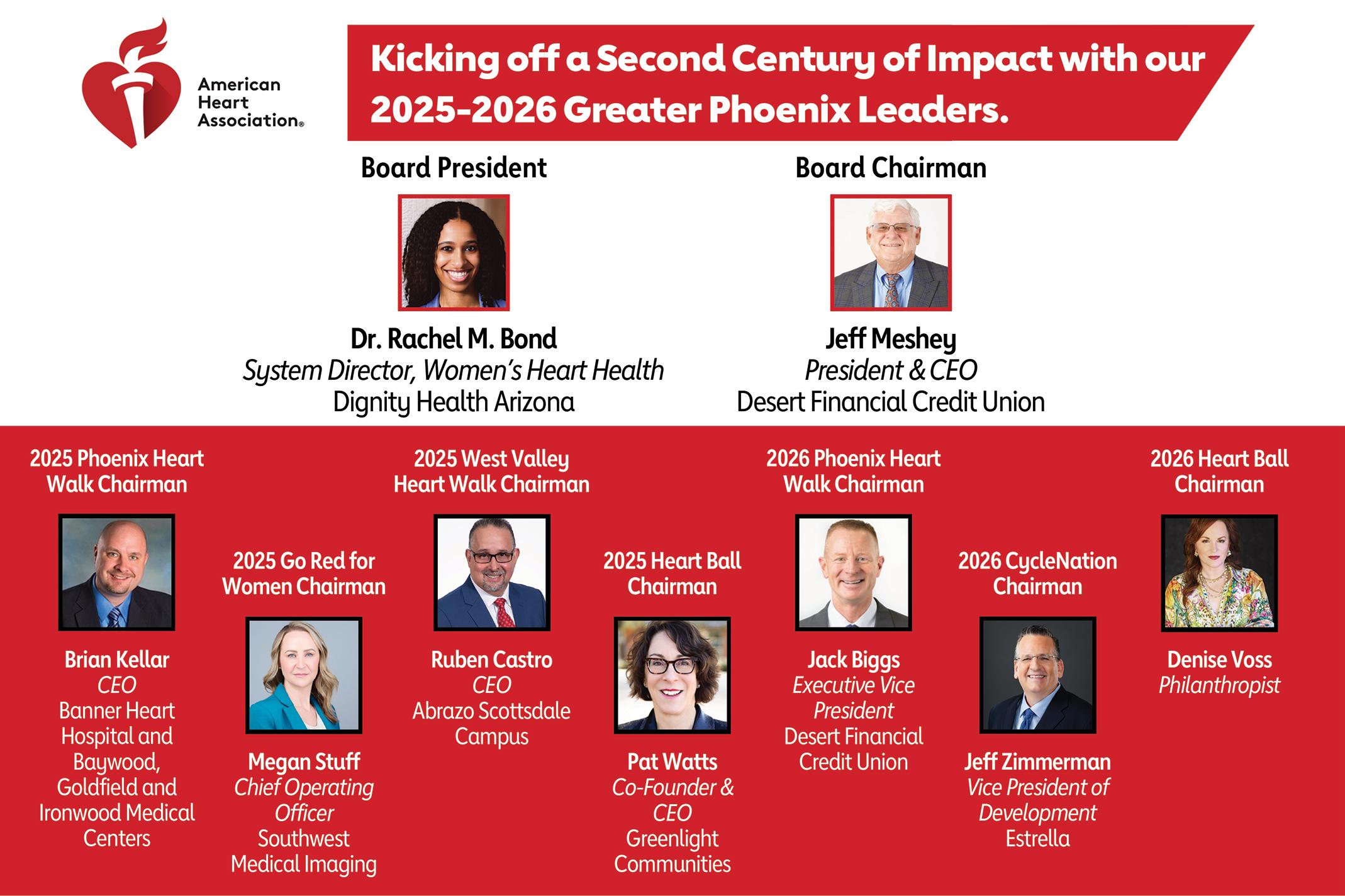




The West Valley positions itself as an emerging powerhouse in both technology and tourism
CULINARY










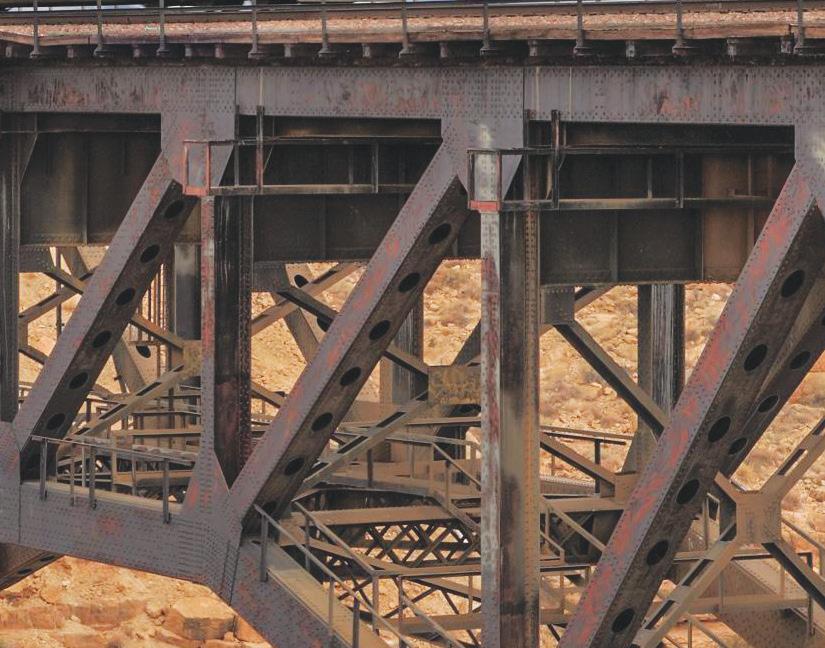
Arizona is booming, and the Logistics Park Phoenix project will be the engine of opportunity powering its future. Backed by a $3.2 billion investment from BNSF Railway, this state-of-the-art freight rail facility in northwest Maricopa County will create over 76,000 jobs and unlock long-term economic prosperity. With a fully integrated intermodal terminal, logistics park, and distribution hub, it’s built to move goods faster and smarter than ever before.
Supercharging supply chains to keep Arizona thriving.

By ERIN THORBURN
Some states have earthquakes, others tornadoes — in Arizona, we get monsoons. While some monsoons are brief and cause minimal trouble, others can inflict significant damage and disrupt business operations, including power outages. When this happens, it’s reassuring to know that help is available. At SRP, dedicated Strategic Energy Managers (SEM) are there to guide companies through outages and help them prepare for future monsoon-related power problems.
From ‘nonsoon’ to monsoon: 2025 will likely see more storms
This year, Arizona is expected to see a rise in monsoons. According to the National Weather Service (NWS), monsoon season is projected to “lean above normal.”
For businesses that depend on uninterrupted services, the prospect of monsoon-related outages can be daunting. But SRP is at the ready to ensure its business partners remain informed and supported at all times.
“SRP prepares year-round for the monsoon season and summer season,” says Pedro Rios, Valued Business Customer Energy Manager (SEM) for SRP. “We do planned maintenance and have monitoring devices in place that will alert us to any interruptions in the SRP grid.”
Rios explains that alerts to the grid prompt an immediate response to safely restore power. At the same time, businesses are kept up to date on all phases of a power outage until power is restored.
businesses
When signing up for an SRP account, business customers receive:
• eNotes: SRP sends text and email alerts to customers notifying them of an outage, its location, the reason for the outage and an estimated restoration time. “These [messages] are updated as the outage goes on, and customers receive a notification when the outage is over and power is back on,” Rios explains.
• Business outage planning checklist: Customers can access a full checklist of business continuity plans, equipment safety, emergency and safety protocols, and employee and customer preparedness for monsoon-related outages at srpnet.com/outagetraining.
• Monsoon season webinar: Just over 10 minutes, this SRP webinar instructs businesses how to proactively plan for monsoon season and beyond.
• Assigned Strategic Energy Manager (SEM): Each business has a dedicated SEM to contact regarding all SRP-related energy needs. They help companies optimize energy usage, reduce costs, improve energy efficiency and prepare and remain informed about weatherrelated outages.
“If there’s an outage, your SEM can report it on your behalf and relay key information, like the estimated restoration time and, if available, the cause,” Rios says. “Our goal is always to restore power within two hours. If it extends beyond that, outage eNotes will keep you up to date with the latest timeline.”
Stay safe during outages
Safety is among SRP’s top priorities. Downed power lines are a major safety concern, and often, individuals are unsure about what to do if they encounter one.
“We always advise SRP customers that if they’re near or around those power lines, to always assume that they’re live and stay away,” Rios says. “The guidance is a minimum of 100 feet of distance between you and the power line; think of staying ‘two semi trucks’ distance away and call 911 when it is safe to do so.”
“It’s recommended that you shuffle away from a downed power line, rather than walking or running away, to reduce the risk of shock,” Rios adds.
One of the best ways to ensure your business is monsoon-ready is to practice safety and emergency protocols throughout the year, such as assigning an emergency and safety point of contact, taking inventory of equipment and applying backup storage when needed, as examples.
“SRP recommends [companies] practice going through an outage,” Rios says. “If you can practice it, even if it’s once or twice a year, then when it does come that time, it will be almost second nature as opposed to a panic reaction.”
To learn more about how to protect your business during monsoon season and how SRP can help prepare and support your company, visit srpnet.com/ customer-service/safety/outages-storm.
From semiconductors to startups, the West Valley’s tech sector is booming thanks to regional synergy and bold innovation
By ERIN THORBURN
The strength of a magnet’s pull depends on its magnetic properties and the strength of its field. There are several reasons why companies like Taiwan Semiconductor Manufacturing Company (TSMC), which is investing $165 billion in its game-changing West Valley facilities, and Amkor, with its $2 billion facility and 500,000 square feet of clean room space in Peoria, have been drawn to the West Valley.
The West Valley has the workforce talent, educational pathways and regional collaboration to support and attract tech and advanced manufacturing businesses now, and in the future.
Growth starts with a spark
In addition to TSMC and Amkor, Microsoft invested $258 million to acquire 280 acres in the El Mirage area to support data center development. But it’s not just the tech giants who are being pulled toward the magnetic tech field of the West
Valley. Startups find that the region is ripe with opportunities to get technology businesses off the ground. In 2024-2025, the West Valley Innovation Alliance aided 47 startups in creating business plans and securing funding.
Several catalysts contribute to the tech sector’s growth in the West Valley, but perhaps chief among them is collaboration.
“WESTMARC has been a force to be reckoned with in transforming the West Valley into a unified, high-performing region for tech sector growth,” says Jeanine Jerkovic, economic development director for the City of Surprise. “Its leadership in convening stakeholders, amplifying regional assets and advancing legislative and workforce priorities ensures we compete effectively for transformational tech investments.”
As part of ongoing collaborative efforts to foster the West Valley’s growing technology presence, the City of Surprise


established “Spark Surprise.” This program is a reimagined initiative for innovation, entrepreneurship and startups within the community.
“In spring 2025, we launched Spark Surprise, a business development hub set to open in the heart of our dynamic new downtown district on Elm Street,” Jerkovic says. “Co-located near our future employment corridor at Surprise City Center, Spark Surprise will serve as a launchpad for founders, providing wraparound services and scalable resources for startups rooted in technology and innovation.”
As of June 2024, Grand Canyon University’s startup business accelerator, Canyon Ventures, housed 13 companies and employed 56 GCU students and 16 GCU alumni.
The accelerator operates out of a co-



working space at GCU, providing resources, support, mentorship, training and more for students and entrepreneurs. Several technology businesses were born through Canyon Ventures and have since flourished. Since its inception in 2020, the startup incubator has helped launch and cultivate several thriving companies in the tech and advanced manufacturing space.
Weston Smith, founder and CEO of Lux Manufacturing, played an integral part in the establishment of Canyon Ventures. Developing electric longboards out of his dorm room presented the young entrepreneur with a dilemma. “My roommates were going to evict me because I had all this stuff just floating around,” he says.
Before his impending eviction, Smith took swift action. “I went and talked to the dean of the business college, who happened to be Dr. Randy Gibb, now the provost, and said, ‘Dr. Gibb, I need a place to work. Can I
have a storage closet?’”
Smith got more than a storage closet and was provided with workspace in an old business complex. A year later, Canyon Ventures was born, with Smith as the accelerator’s first occupant.
Now, Smith heads up Lux Manufacturing, a company that provides high-precision CNC milling and lathe operations, solid model machining and high-volume assembly for a range of industries, including medical devices, industrial equipment, sustainable energy, semiconductors and consumer electronics.
Kevin Vega and Suman Dangol, cofounders of Vox Custom AI Solutions, are also part of Canyon Ventures’ entrepreneurial ecosystem.
“Canyon Ventures has been more than just a home base,” Vega says. “It has been the engine behind our acceleration. Being
in the West Valley puts us in the middle of a growing innovation ecosystem, but what really helped us take off has been the support of Robert Vera, the founding director of Canyon Ventures.”
Dangol adds, “Robert has been pivotal to the growth of The Vox Company as a mentor, connector and early believer in what we’re building.”
Since their time with Canyon Ventures, Vega and Dangol earned $5,000 and the AZ Venture of the Year Award at GCU’s Demo Day in February for their Vox Box, touted as the world’s first AI-powered business consultant in a box. The Vox Box produces solutions for businesses by providing artificial intelligence, design, branding and marketing services.
“Winning AZ Venture of the Year was a major milestone for us,” Dangol explains. “It validated everything we’ve been working toward and showed that Arizona is ready to lead in AI.”





The co-founders agree that the AZ Venture of the Year Award helped Vox’s credibility with new clients and partners and opened doors to bigger opportunities.
“We’re building on that momentum by expanding into new industries, launching more AI solutions and growing our team,” Vega says.
As Vox continues to scale, Vega and Dangol have come full circle with Canyon Ventures and GCU.
“Thanks to the foundation of Canyon Ventures, we’ve been able to tap into amazing student talent from GCU, partner with other startups and connect with a strong network of local business leaders and investors,” Dangol says. “Canyon Ventures gives us more than just a place to work. It gives us momentum.”
In addition to Canyon Ventures, Grand Canyon University’s Colangelo College of Business — working in partnership with the City of Peoria — launched the GCU Entrepreneur Training Program, a free, four-month initiative designed to support startups and small businesses while driving economic development in Peoria, and this includes the tech sector.
“If there’s ever a time to be an entrepreneur, I believe now is the time,” says Robert Vera, founding director of
Canyon Ventures. “I think that it’s a really great time for the City of Peoria and for the country, so we’re really excited to be able to deliver this.”
Collaboration continues
Above and beyond cultivating new tech businesses and startups, collaborative efforts between cities and educational institutions are also bolstering the West Valley’s workforce pipeline.
“In a high-tech economy, workforce is infrastructure and Surprise is fully committed to developing a futureready talent pipeline,” Jerkovic says.
“We collaborate with key educational institutions like Ottawa University-Arizona (OUAZ), West-MEC, the Dysart Unified School District CTE programs and Estrella Mountain Community College to deliver responsive, employer-informed curricula in high-demand fields like cybersecurity, software engineering, robotics and applied technology.”
Surprise also has a CTE Competition Series with OUAZ, launched after successfully hosting the 2024 Future Business Leaders of America Region 4 Conference. In 2025, Surprise scaled the initiative to include Arizona HOSA (a global, student-led organization that focuses on empowering future
health professionals through education, collaboration and experience) and DECA (formerly Distributive Education Clubs of America), bringing more than 1,500 students from across the state to compete at the shared Surprise City Hall–OUAZ downtown campus.
“These immersive, career-based competitions aren’t just resume-builders; they’re gateways to real-world tech experience and employer engagement,” Jerkovic says.
Maricopa Community Colleges (MCC) has also partnered with heavy hitters such as Intel to develop an accelerated Semiconductor Technician Quick Start program, recognized as a national model for rapid workforce development.
According to WESTMARC’s “West Valley Industry Growth Projection (2022 to 2030),” technology employment is poised to experience a 13% increase between 2022 and 2030. Education stakeholders and workforce development partners are ready and prepared to support the rapid growth taking place in the West Valley.
“Regional collaboration positions the West Valley as a credible and compelling destination for advanced industry growth,” Jerkovic concludes.

The West Valley’s educational pathways connect students to careers and fuel the West Valley’s workforce needs
By ERIN THORBURN
The West Valley is a powerful example of how prioritizing educational pathways and continuity pays off, not only for students but also in sustaining the growing workforce needs of a rapidly expanding region. The Academies, designated as Arizona’s first Ford Next Generation Learning (Ford NGL) in February 2025, have been one of the most recent examples of how preparing a skilled workforce for high-demand, well-paying careers can be transformative for a region, resulting from regional educational alignment and collaboration.
Academies: Strengthening the bridge between high school and workforce
The Academies are part of the Agua Fria High School District’s (AFUHSD) 10-year strategic plan to enhance educational opportunities and better prepare students for future careers. This initiative ensures a tailored academic experience that prepares students for diverse futures — college, trade school, entrepreneurship, employment, military service or community service.
The West Valley is experiencing significant growth, with projections indicating that 40% of Maricopa County’s
population growth will occur in this area by 2030. As a result of this growth, major employers in sectors such as healthcare, manufacturing and technology are flocking to the region, with Tawain Semiconductor Manufacturing Company (TSMC) and Factor — a ready-to-eat meal delivery service — as prime examples. These operations and others will employ thousands of workers. The challenge: Approximately 70% of the West Valley’s workforce still has to commute east to work. Here’s where the Academies step in. “The designation and launch of the
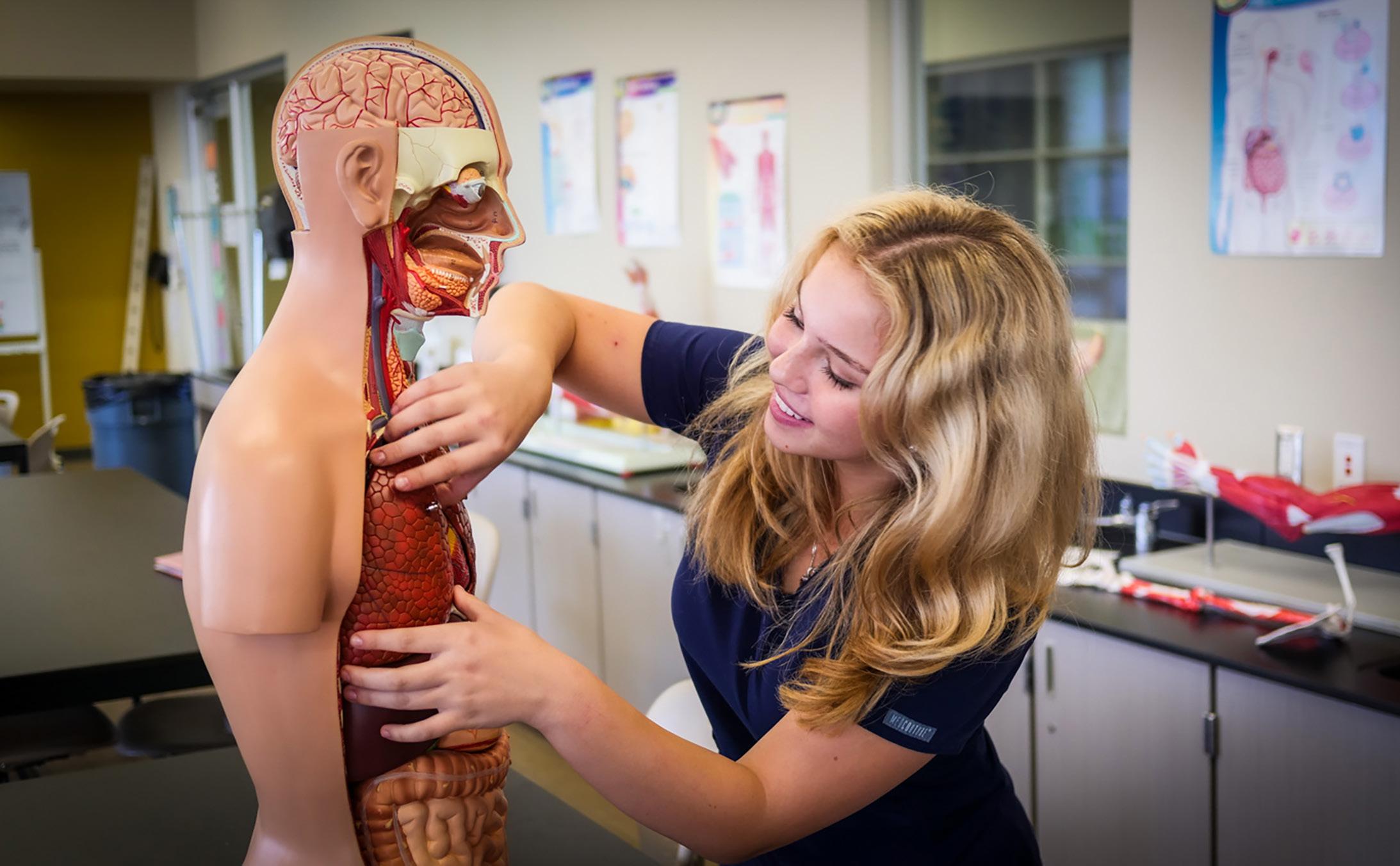
MAKING THE GRADE: “In addition to traditional academic skills, our Career and Technical Education (CTE) programs emphasize durable skills development such as problem-solving, collaboration, critical thinking and creativity, as well as character skills like fortitude, growth mindset and leadership,” says Peoria Unified School District Superintendent Dr. KC Somers. “These skills will serve all Peoria Unified students well, regardless of what career pathway they choose.” (Photo provided by Peoria Unified School District)
Academies of the Southwest Valley are significant achievements for our community, reflecting our commitment to preparing a skilled workforce for high-demand, well-paying careers,” said Mark Yslas, superintendent of AFUHSD. “It underscores the District’s role in driving economic growth and improving the quality of life in our region. Our community can take great pride in this milestone, which marks a new era.”
In addition to ensuring that the West Valley’s workforce pipeline — a coordinated regional effort across K-12, community colleges, universities and industries to prepare students for future jobs — remains fueled for future needs, the Academies work to ensure that students have the guidance and support required to meet their specific postsecondary goals.
“Not every path leads to college, and that’s OK,” Yslas says. “Some students will enter the workforce right away, others will pursue trade programs, the military or start their own businesses. The Academies are designed to help them figure out what’s right for them, before they graduate.”
West-MEC: A pathway to career preparedness
The Academies and West-MEC share a vision: To provide students with real-world career learning and experiences to help set them up for success after high school. Whereas the Academies provide structured coursework and career exploration around themed pathways within each high school, West-MEC provides hands-on specialized training and credentials in fields such as welding, HVAC, healthcare, technology and more.
The collaboration between AFUHSD and West-MEC has removed several educational access barriers.
“One of the biggest obstacles for career and technical education (CTE) is transportation,” says Dr. Scott Spurgeon, superintendent of West-MEC. “The state doesn’t fund it, so students have to find their own way to and from our programs; some drive, some catch rides and others rely on public transportation.”
As fate would have it, five acres of land was available right behind Agua Fria High School.
“West-MEC purchased that land and this August, we’ll be opening the WestMEC Career Academy at Agua Fria,” Spurgeon says. “Now, students attending

Agua Fria High School who are accepted into a West-MEC program can just walk across the athletic fields to attend classes and return to campus with ease.”
The new site will host four high-demand programs: Electrical, HVAC, medium/ heavy diesel and welding.
“Each program leads to an industryrecognized credential, which means students can go straight into the workforce and start a strong career path right after graduation,” Spurgeon notes.
In tandem with collaborating with AFUHSD, West-MEC, under Spurgeon’s leadership, actively and continuously assesses the needs of incoming businesses to the West Valley. In doing so, curriculum pathways can be designed to help fulfill the demands of a future workforce and make sure students are career-ready when these businesses launch.
“This kind of collaboration doesn’t happen by accident,” Spurgeon says. “The West Valley is strategic and intentional about communicating across districts and organizations. We work as partners, not competitors.”
ASU West: Using interdisciplinary pathways to bolster the West Valley Pipeline
Arizona State University’s West Valley Campus (ASU West Valley) plays a pivotal
role in the West Valley Pipeline strategy and participates in WESTMARC’s Education & Workforce Development Committee, a coalition of educators, business leaders and government. Together, this group strengthens educational pathways from K-12 to CTE and higher education opportunities.
“Many are surprised to learn that hundreds of high school students already attend the West Valley campus,” says Todd R. Sandrin, vice provost of ASU West Valley. “The Gary K. Herberger Young Scholars Academy is a learning environment designed for highly gifted students in grades 7-12 located on ASU West Valley campus.”
Sandrin adds that ASU Prep Digital+ is an innovative hybrid program for students in grades 9–12, blending online learning with real-world experiences on campus to prepare for college and careers.
“These students spend one to three days on campus each week, learning from college faculty and earning college credit even before high school graduation,” he continues.
In response to the West Valley’s evolving workforce needs, ASU West Valley introduced three new schools in the past two years:
• The School of Integrated Engineering equips students with cross-disciplinary skills essential for emerging industries



such as microelectronics and advanced manufacturing.
• The School of Technology, Innovation and Entrepreneurship (TIE) ties together business, tech and real-world problemsolving, offering degrees and initiatives like the SMB Lab to lift up local businesses and cultivate entrepreneurial talent.
• The School of Interdisciplinary Forensics — the first of its kind in the nation — prepares students to apply scientific and technical knowledge across justice, healthcare and public service sectors.
“Together, these schools ensure students are not only career-ready but positioned to lead in the industries shaping the West
Valley’s future,” Sandrin explains. “Interdisciplinary learning plays a critical role in preparing students for today’s and tomorrow’s job markets by equipping them with the versatility, problem-solving skills, and adaptability needed in an increasingly complex and interconnected world.”
Western Maricopa Education Center (West-MEC), a career and technical education public school district, announced their 2025-26 school year openings for high-opportunity programs. These programs focus on industries that have a low supply of skilled workers, but a high demand from employers including robotics, coding, pharmacy science, EMT and so much more.
ADVANCED MANUFACTURING: Offers a comprehensive curriculum covering 14 key standards while students gain hands-on experience with industry-standard equipment and work with advanced systems such as the Festo MecLab, AC/DC Trainers, Hydraulics & Pneumatics Training Systems and PLC Training Systems.
AUTOMATION & ROBOTIC SYSTEMS: Equips students with the fundamental engineering principles and technical skills necessary for managing industrial automation control systems and technologies, mainly focusing on integrating artificial intelligence in the control of machines within manufacturing processes.
CODING: Interactive program that teaches students how to design and develop software, build apps for phones, tablets, websites, and write and test computer code.
PRECISION MACHINING: A two-year program allowing students to gain insight on the select tools and materials needed to make durable goods, read blueprints, comprehend CNC theory and procedures, utilize machine shop math, etc.
COLLISION REPAIR & REFINISHING: Hands-on repair program teaching metal work, basic painting and color matching, cost estimation, industry safety protocol, structural analysis, computer diagnostic systems and welding in collision repair.
ELECTRICAL TRADE SPECIALTY: Introduces students to the basic elements of electrical systems, allowing them to analyze construction drawings, perform maintenance on electrical circuits, work with control systems, install lighting and motors.
EMERGENCY MEDICAL TECHNOLOGY: Consists of first-response care, CPR, measuring vital signs, bandaging and other life-saving procedures.
WATER SYSTEMS: Exposes students to real-world situations and current challenges related to clean and abundant water supply, efficient wastewater treatment and management, and general environmental concerns.
IT SECURITY: Focuses on the foundational principles of securing computer networks and managing risk while training students on managing networks, ethical hacking defense, troubleshooting Linux OS and mitigating security risks.
LAW & PUBLIC SAFETY: Offers training in basic skills used in patrol functions, defensive tactics, use of force and first aid. Students will learn constitutional law, forensic science, first aid / CPR and more.
PHARMACY SCIENCE: Teaches students the delivery of pharmaceutical services alongside licensed pharmacists in a pharmacy setting.
POWERSPORTS TECHNOLOGY: Prepares students with technical skills to service, maintain and diagnose powersport vehicles, such as motorcycles, all-terrain vehicles (ATV’s), utility terrain vehicles (UTV’s) and personal watercraft.

Western Maricopa Education Center (West-MEC) is a career and technical education school district in the West Valley. West-MEC serves over 45,000 students each year through its central and satellite programs. It has four campuses where its central programs are located. The campuses are in Buckeye, Surprise, Glendale and North Phoenix. West-MEC is building its fifth and largest campus, which is in phase one of its development, and will be located in Glendale on Thomas and the Loop 101.
In career and technical education, staying on top of current industry trends is essential. West-MEC prides itself on staying current with its curriculum. It is more important than ever for West-MEC, especially when it comes to the amount of industry flocking to the West Valley, some even calling the West Valley and Phoenix the “Silicon Desert.”
To help meet local industry needs, WestMEC has created multiple new programs in recent years, tailored curriculum in others, and added more locations for some of the most “in-demand” programs.
For example, West-MEC is adding an Advanced Manufacturing program at its Northeast Campus this Fall to help meet the needs of local manufacturing entities in the West Valley. Some of the companies the district has collaborated with to build this program include Gatorade, Amkor, Nestle and more.
West-MEC also added Cloud Technology and Automation & Robotics Systems programs this past year to help accommodate the needs of Amazon and TSMC, respectively. West-MEC is also adding welding to three new locations this Fall to keep up with the immense demand for welders.
As a result of this industry-focused approach, West-MEC students earned over 7,000 credentials last year, which are clear indicators of career readiness that employers recognize.
In a recent employer survey, 97% of employers stated that West-MEC students met or exceeded expectations for entrylevel new hires. The same percentage also said that West-MEC students met or exceeded professional expectations for
communication, teamwork, attendance and work ethic, rating teamwork and communication as highly valued professional skills.
A few more projects that West-MEC is working on, such as the Career Academy in conjunction with the Agua Fria Unified School District and the skilled education center in Peoria, will help bolster WestMEC’s footprint and give as many students as possible the opportunity to gain skills that are needed in the workforce. The Career Academy is innovative in that it is located near the transportation corridor on I-10 to work closer to companies and establish a talent pipeline to these industries.
These are just some of the ways WestMEC stays agile in responding to the evolving demands of local and incoming industries. By doing so, students gain access to the latest knowledge, hands-on skills, and valuable industry connections that align directly with their chosen programs. This translates to a faster way forward into the workforce for students pursuing their professional goals.

Strategic infrastructure, transportation upgrades and smart planning are accelerating West Valley communities into a high-growth future
BOOMING REGION: Village at Prasada serves as the retail centerpiece of a massive 3,355-acre master-planned community, with homes, parks, schools and job centers. (Photo provided by SimonCRE)
By ERIN THORBURN
Anyone who’s played Jenga knows that one shaky or misplaced wooden block can send a tower tumbling down. The right pieces in optimal places, however, can build solid, high-reaching structures. The West Valley has long recognized and prepared for exponential growth throughout the region. Much like players in a Jenga game, infrastructure, transportation and housing must all work in tandem to support expansion, and West Valley leadership is playing a steady game.
All roads lead to Prop 479
“Roads? Where we’re going, we don’t need roads” is one of the most well-known Doc Brown quotes from “Back to the Future,” but it doesn’t ring true for the West Valley (at least not anytime soon).
According to Maricopa Association of
Governments (MAG) projections, the West Valley’s population is expected to surge past 2 million residents by 2030. That’s a lot of drivers in need of many roads leading to and from the new housing and employment developments occurring throughout the West Valley.
Enter Prop 479, the continuation of an existing, dedicated half-cent sales tax in Maricopa County to fund transportation.
“Proposition 479 is going to have a tremendous impact, not just for Surprise, but for the entire West Valley,” says Kevin Sartor, mayor of Surprise. “There’s so much growth happening out here, and infrastructure has to keep up.”
When compared to a 2050 no-build scenario, the transportation improvements included in the Prop 479 investment plan are projected to offer multiple benefits,
including reducing average daily traffic delays by more than 51,000 person-hours across key corridors, according to MAG.
“One of the biggest regional benefits is State Route 30,” Sartor says. “Even though it’s not in Surprise, SR 30 will help a lot of our residents who commute east to Phoenix or downtown by relieving pressure on the I-10 and improving overall traffic flow. It’s a big deal for quality of life.”
Beyond providing freeway relief, Prop 479 investments include strategic interchange upgrades, arterial street improvements and expanded transit options.
“If we’re talking about Surprise specifically, one of our top priorities is the US 60 and Loop 303 interchange,” Sartor explains. “Our city’s growth is happening in the north and west. Right now, there’s





only one main road — 163rd Avenue — serving those areas. Proposition 479 helps us fund key upgrades like a grade separation at 163rd and US 60 (so drivers aren’t stuck waiting on train traffic) and a new interchange at 155th Avenue and Loop 303.”
Infrastructure investment is vital when companies like Taiwan Semiconductor Manufacturing Company (TSMC) land in the West Valley, bringing in thousands of new employment opportunities — in the case of TSMC, 6,000 direct, high-tech jobs.
“TSMC has created a new orbit for employers, developers and the entire manufacturing ecosystem,” says Jason Morris, founding partner of Withey Morris Baugh.
Of course, part of the semiconductor manufacturing giant’s “orbit” includes Halo Vista. The self-contained $7 billion community, anchored by TSMC’s $165 billion investment, has been described


as a “city within a city” and is expected to support up to 70,000 jobs over time through direct employment and related development in the surrounding area.
“Halo Vista is blessed with a blank canvas, but also with the incredible momentum provided by TSMC,” Morris says. “Just as TSMC represents the future of manufacturing, Halo Vista is looking at every aspect of its development as an opportunity to be cutting edge. This innovation starts with the infrastructure and includes every aspect of the master
plan — from the water and sewer to the roadways, buildings and the end-users.”
As for Halo Vista’s relationship to West Valley’s infrastructure and transportation corridors, once State Route 30 (under Prop 479 funding) is built, it will link Loop 303 to Loop 202, offering more direct routes and freeing up driver dependency on the I-10.
In Surprise, Mayor Sartor’s mention of prioritizing US 60 and Loop 303 interchange focuses on accessibility to and from one of its city epicenters: Village at Prasada. Prasada serves as the retail centerpiece of a massive 3,355-acre master-planned community, with homes, parks, schools and job centers.
“The Loop 303 was a huge catalyst in shaping Surprise into what it is today,” Sartor explains. “While other cities along the corridor built out with logistics and warehouse space, Surprise focused on retail, restaurants and places for people to gather. Prasada is now the number one power center in Arizona, and it’s not just serving Surprise, it’s a regional draw.”
Microtransit is a cost-effective mode of transportation that doesn’t require a heavy infrastructure lift. Additional benefits: it’s scalable, flexible and equitable, well-suited for rapidly growing regions — like the West Valley. MicroTolleson launched its microtransit service on October 1, 2022, transitioning from Valley Metro’s Zoom bus service to rideshare-based transportation using Uber and Lyft.
HOW IT WORKS: On-demand, app-based rides within Tolleson city limits.
LOW FARES: A $2 base fare, with the city subsidizing up to $15 per ride (riders only pay the remainder).
FREQUENT EVALUATION: Service zones, fares and destinations are reviewed regularly to ensure responsiveness to local needs.
TAKEAWAY: Microtransit programs such as Tolleson’s T-Town Trolley act as a bridge to long-term infrastructure planning, filling gaps during transportation improvements (e.g., SR30 and Loop 303). They’re particularly effective in lower-density areas that may be underserved or unavailable by buses or light rail options. Plus, microtransit serves as a go-between for park-and-rides, bus hubs or even future light rail stops, improving access in sprawling suburban settings.

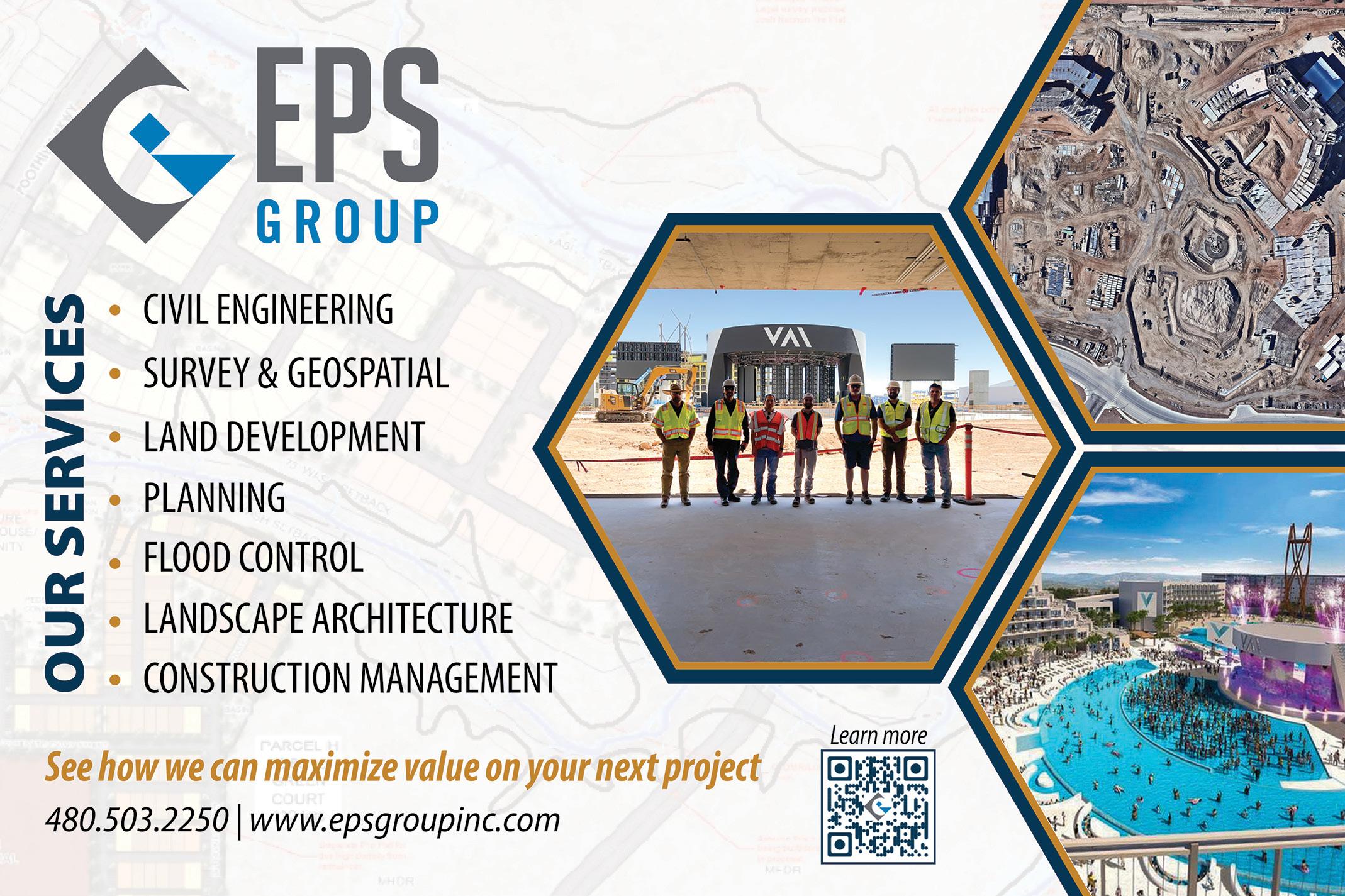

Thanks to mega-events, rural charm and regional collaboration, tourism in the West Valley is thriving year-round

By ERIN THORBURN
Meals and drinks can be supersized, so why not tourism regions? The Phoenix-metro area welcomed 46.7 million visitors in 2023, a 4.7% increase from the previous year, and the West Valley played a major part in attracting those visitors. State Farm Stadium, Desert Diamond Arena, Phoenix Raceway and other venues throughout the West Valley have contributed to super-sized tourism and economic impact throughout the West Valley — and there’s no sign of stopping.




Sports and spectacle: Super Bowl, spring training and Swifties Sports venues in the West Valley are popping up faster than gophers on a golf course (and the region has plenty of those, too — golf courses, not gophers). The thing about these venues is that while they house some of Arizona’s most beloved teams, these stadiums, fields and casinos also bring in huge headliners like Taylor Swift, The Weeknd and Post Malone (with more big names to come).
“There’s been a clear shift in demand toward multi-purpose venues that can accommodate a variety of year-round events, from professional sports and concerts to cultural festivals and corporate gatherings,” says Ron Price, president and CEO of Visit Phoenix. “The West Valley is uniquely positioned to meet this trend. State Farm Stadium has demonstrated its ability to seamlessly host everything from NFL games to major concerts and even Super Bowls.”
Spring training is another top tourist attraction for the West Valley. Collectively, the Cactus League generated $710 million in total economic impact in Arizona from the 2023 season, according to Arizona State University’s Seidman Institute.
“Over the past 25 years, the West Valley has become home to nine of the 15 Major League Baseball teams that play in the Valley,” says Sintra Hoffman, president and CEO of WESTMARC. “One of those teams has made it to World Series eight times in the past 10 years.”

Biomedical Sciences
Cardiovascular Science
Clinical Psychology
Dental Medicine
Nurse Anesthesia
Nurse Leadership
Nursing Practice
Occupational Therapy
Optometry
Osteopathic Medicine
Pharmacy
Physical Therapy
Physician Assistant
Podiatric Medicine
Precision Medicine
Public Health
Speech-Language Pathology
Veterinary Medicine
Downers Grove Campus
555 31st Street, Downers Grove, Illinois
630-515-7200 | admissil@midwestern.edu
Glendale Campus
19555 N. 59th Avenue, Glendale, Arizona
623-572-3215 | admissaz@midwestern.edu
Desert Diamond Arena, once home to the Arizona Coyotes, quickly pivoted upon the team’s departure, thanks to swift leadership. Immediately, they increased concerts and private events. Now, the arena is home to the Arizona Rattlers indoor football team.
In Peoria, the Peoria Sports Complex is now the official home of Desert Dreams F.C., Arizona’s first women’s professional soccer team.
“The recent announcement that Surprise Stadium will host the Big 12 Baseball Championships is yet another testament to the West Valley’s readiness and capability to host high-profile events,” Price says.
Phoenix Raceway draws visitors near and far. Non-locals account for 60-71% of raceway ticket buyers, and according to WESTMARC, spend an average of $452 per day during their visit.
Visit Phoenix is committed to a collaborative and inclusive approach to destination marketing that highlights the unique character of each community.
— Ron Price
Regional collaboration: Making tourism a shared success
Creating a robust entertainment ecosystem has been part of what has helped shape the West Valley as a tourism destination. A dedication to building “the total visitor experience” has remained at the forefront of collaborative regional tourism efforts.
“Visit Phoenix is committed to a collaborative and inclusive approach to destination marketing that highlights the unique character of each community,” Price explains. “Glendale, Avondale and Surprise each offer distinct experiences that enrich the visitor experience. Our role is to amplify these local stories on a regional and national scale.”
Price adds that success has come from partnering closely with local tourism and city partners to spotlight events, attractions and new developments across Visit Phoenix’s media outreach, travel trade efforts, convention sales and digital marketing channels.
WESTMARC also takes great measures to secure and foster tourism partnerships. The $1 billion VAI Resort and Mattel Theme Park in Glendale, for example, has been heavily promoted by WESTMARC and aligned stakeholders. This type of attention elevates the region’s tourism profile and capacity significantly.
Among its many other target tourism efforts, again looking holistically at the entertainment ecosystem, is highlighting the supporting developments surrounding major venues. This

includes Topgolf, Andretti Karting, Avondale’s global cuisine (with more than 12 different countries represented), Lake Pleasant as a premier aquatic destination and more.
“The West Valley’s tourism scene has something for everyone,” Hoffman says. “Whether you’re looking for sports, concerts, outdoor recreation, water sports, family events or unique restaurants, the West Valley has it all.”
Rural charm and heritage
Californians often say how they appreciate being able to shift between beach, mountains and forest — all in a matter of a short drive. The West Valley offers a similar advantage in that someone can attend a headliner show at State Farm Stadium and take a little over an hour drive to Wickenburg for a taste of authentic western culture.
“We are known for our team roping competitions and cowboy heritage, which draws thousands of visitors every year, especially during the winter season,” says BG Bratcher, mayor of Wickenburg. “There are also several other equestrian events such as barrel racing, cutting, penning and trail riding.”
Added to its rustic charm, Wickenburg is recognized for its award-winning world-class Desert Caballeros Western Museum and the state-of-the-art 600-seat Del E. Webb Center for the Performing Arts.
“Just a few miles from Wickenburg is Vulture City, the most unique and authentically restored ghost town that was once a thriving mining town,” Bracher says. “Down the road is Maricopa
County’s Vulture Mountains Recreation Area (phases II and III are in progress).”
Bracher stresses how rural and heritage tourism is more important than ever. “Big-city events are great, but not every traveler wants only fast-paced experiences,” she says. “Many people also look for authenticity. They want to slow down, connect with local culture and have memorable experiences.”
Future West Valley tourism outlook
One good challenge for any growing tourism epicenter to have is an overabundance of visitors and not enough places for them to stay — a scenario in which the West Valley currently faces.
“While visitor counts are in the millions, our resort rooms are not yet keeping pace,” Hoffman says. “There has been increasing investment in brand properties locating in or around entertainment centers in recent years; however, the VAI Resort with 1,100 hotel rooms and onsite restaurants and entertainment will be a game-changer for the West Valley’s tourism scene.”
Even though it may take time to produce beds for heads, the West Valley has shown that patience, backed by persistence, always pays off.
“Given our year-round tourism activities, ranging from hiking, biking, horse riding, golfing, plus five different kinds of professional sports, the West Valley is definitely positioned to host visitors all 12 months of the year,” Hoffman says. “We have beautiful mountain ranges to host large-scale resorts, but need investors with our vision.”
Here are some of the West Valley hotel construction projects expected to wrap up in the next 12 months:

BILLION-DOLLAR GEM: The $1 billion VAI Resort and Mattel Theme Park in Glendale, which is scheduled to open in December, has been heavily promoted by WESTMARC and aligned stakeholders. (Photo provided by VAI Resort)
JULY 2025
Fairfield Surprise Prasada
13430 N. 163rd Dr., 60 rooms
JULY 2025
TownePlace Suites Surprise Prasada
13430 N. 163rd Dr., 50 rooms
AUGUST 2025
La Quinta Inn & Suites by Wyndham Phx
9050 W. McDowell Rd., 95 rooms
SEPTEMBER 2025
SpringHill Suites by Marriott Surprise
16840 N. Civic Center Dr., 106 rooms
DECEMBER 2025
VAI Resort
9601 W. Cardinals Way, 1,100 rooms
JANUARY 2026
Home2 Suites by Hilton Goodyear Phoenix West 1950 N. Litchfield Rd., 112 rooms
JANUARY 2026
LivAway Suites Tolleson Interstate 10 and 91st Avenue, 126 rooms
FEBRUARY 2026
LivAway Suites Glendale 9930 W. Desert River Blvd., 126 rooms
MARCH 2026
LivAway Suites Surprise
14020 W. Mountain View Blvd., 126 rooms
APRIL 2026
Hampton Inn & Suites by Hilton Buckeye Verrado Way, 108 rooms
MAY 2026
Home2 Suites by Hilton Peoria North Phoenix W. Jomax Rd. and N. Lake Pleasant Pkwy., 103 rooms
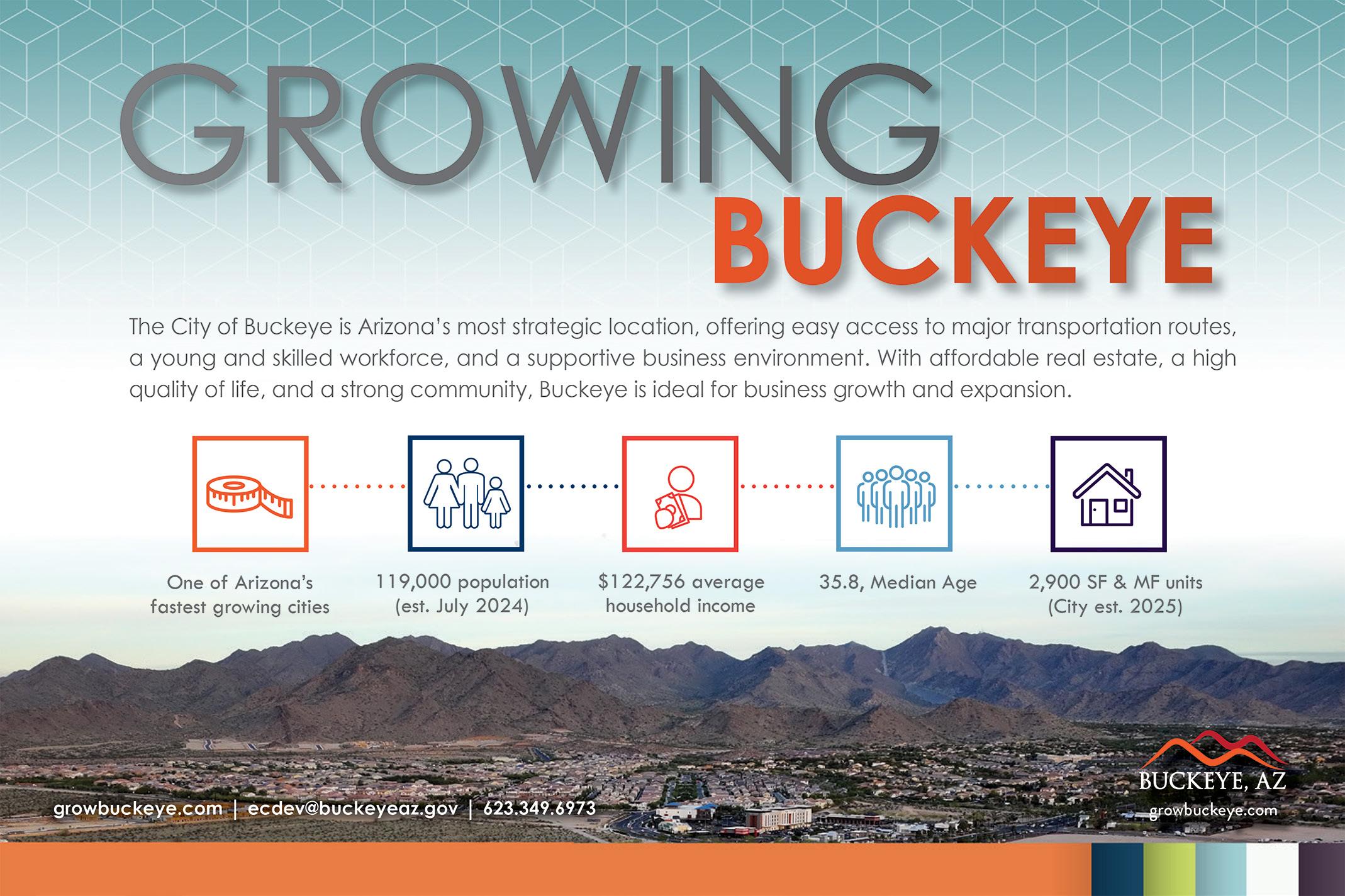









Arizona’s housing market is defined by cautious optimism and complex realities in 2025
By LUX BUTLER
If Arizona’s residential real estate market had a crystal ball, its forecast would read: “cautious optimism.”
Experts across the housing industry, from builders to bankers, forecast a 2% to 5% increase in existing home sales, even as the country deals with economic uncertainty. Median home prices are expected to stay relatively stable, supported by rising inventory, strong in-migration and job growth, especially in the Metro Phoenix area,
which is widely expected to be one of the top 10 housing markets in the U.S. this year.
Underlying those hopeful projections are complex realities: Affordability pressures, mortgage rate volatility and policy questions continue to shape buyer behavior and development strategies.
To better understand the landscape, Az Business spoke with homebuilders, brokers, mortgage lenders, title professionals and real estate attorneys who offer a
comprehensive look at what’s happening in Arizona housing and what’s coming next.
Despite the sometimes bleak headlines, many Arizona real estate professionals say the local market is far from stagnant.
“The headlines scream doom and gloom, but it’s busy, we’re working hard,” says Mike Zschunke, a real estate broker and agent in the Phoenix area who primarily handles

high-end properties in North Scottsdale.
“Sellers think it’s 2021 and buyers think it’s 2008. Getting everybody on the same page is the hard part,” he says.
While the frenzied bidding wars of the pandemic era have cooled, demand hasn’t disappeared. For Zschunke, business continues as usual.
“I wrote four offers last week,” he says. “One was on a $6 million listing, we came in closer to $5 million based on comps.
But the seller didn’t need to sell, so they wouldn’t budge.”
Buyers are adjusting to higher interest rates with more confidence than expected. For serious house-hunters, 6% is no longer a deal-breaker.
“They know if rates come down, prices will just go up,” Zschunke adds.
That sentiment is echoed by experts on the lending side. David Hyde, vice president and senior home loan manager at BOK
Financial Mortgage, says rates are hovering between 6% and 7%, but qualified buyers are still moving forward.
“If you can afford to buy, nows probably a good time,” Hyde says.
Pending home sales rose 6% in March and April and while inventory is ticking upward, it’s still falling short in highdemand neighborhoods.
“We’re seeing more homes come to market,” Zschunke notes, “but we’re not where we need to be.”
Phoenix continues to be a magnet for new residents and investors.
“I’m cautiously optimistic, quite honestly,” says Brad Schoenberg, division president at Taylor Morrison. “In the great state of Arizona, we don’t have hurricanes, we don’t have earthquakes, we still have great migration from feeder states from around the country, we are still relatively affordable when you compare us to competing markets, whether that is other markets in the Southwest or if you stretch into Denver and definitely when you stretch back over to California.”
A key driver is economic diversity. “We’re not just about construction anymore. We’ve got tech, biosciences and manufacturing, especially with the TSMC chip plant in the North Valley and Intel in the South Valley. That’s drawing high-wage workers who want to live close to where they work,” Schoenberg explains.
The U.S. Census Bureau supports Schoenberg’s observations: Phoenix has been a hot spot for growth over the past decade. Between 2020 and 2024, the city has seen a 4% increase in population.
Rising household incomes has also expanded opportunities for buyers in the Phoenix area. Schoenberg notes that the median household income in the metro region reaches approximately $90,000.
“Phoenix is a growing market,” says Derrick Barker, CEO of Nectar. “The inmigration and job growth make this one of the top places to deploy capital.”










COMMUNITY EMERGES: Floreo Community Center will be where Teravalis, a massive 37,000-acre master-planned community currently under construction in Buckeye, comes together. Opening in 2027, Floreo Community Center will be the place where residents and neighbors can meet and share interests. (Rendering provided by Howard Hughes)
Buyer psychology has shifted since the pandemic and the market reflects that, experts say.
“Sellers don’t need to sell and a lot of buyers don’t need to buy,” Zschunke says. “Many are moving up or down, but they’re comfortable where they are.”
It’s an attitude shaped by what many now call mortgage lock-in. About 60% of homeowners have a mortgage rate under 6%, creating a sense of being stuck, yet not entirely without options.
“They feel trapped,” Zschunke says, “but many have enough equity to move if they want to. They just need someone to show them how.”
The profile of the first-time buyer has changed as well. Twenty years ago, the average first-time buyer was around 30 years old, today many are closer to 40. With that shift comes more income, more stable careers and often financial support from family, giving them a different set of expectations and pressures than previous generations. Even in the luxury market, caution is becoming the norm.
“A lot of people buying large homes are coming in with huge down payments,” Hyde says. “It’s a shift we didn’t see as much before and it shows how people are
thinking more conservatively, even at the high end.”
While affordability remains a growing concern, it hasn’t shaken residents’ loyalty to Arizona. According to new data from BMO’s Real Financial Progress Index, only 49% of Arizonans say they’d consider leaving the state to afford a home, meaning more than half would rather weather higher costs for the lifestyle, opportunity and identity the state continues to offer.
If there’s one issue that unites residential real estate professionals, it’s affordability.
“Affordability and consumer confidence are what keep me up at night,” Schoenberg says. “There’s a lot of supply pressure. We still don’t have enough affordable homes for the people who want them.”
Although Phoenix is seeing a wave of new construction, the benefits aren’t being felt evenly across the market. Barker notes that a large number of new units are coming online this year, potentially hitting a peak. Despite the influx, financing remains a challenge. Lenders are tightening up and properties with solid fundamentals are struggling, not because they’re flawed, but because of bad timing.
“Liquidity is down,” Schoenberg explains.
“There are great properties facing distress simply due to timing.”
That disconnect creates opportunities for some investors, but also hardship for others.
“We’re investing alongside developers who have solid assets but can’t get the financing they need,” he continues.
For homeowners, many choose to renovate rather than relocate.
“Home equity loans are up,” Hyde says. “People are adding pools, updating kitchens, turning 20-year-old homes into more modern spaces. It’s often easier than buying something new at today’s prices.”
While financing is still accessible, the process is more difficult than it used to be.
“Pre-approval is the new standard,” Hyde says. “We used to do pre-qualifications over the phone. Now we’re reviewing credit, income and assets up front, so the only thing missing is the house.”
In a competitive market with limited inventory, buyers need every advantage.
“It’s the difference between closing in two weeks versus 45 days,” he adds. “That timeline can be critical when multiple offers are on the table.”



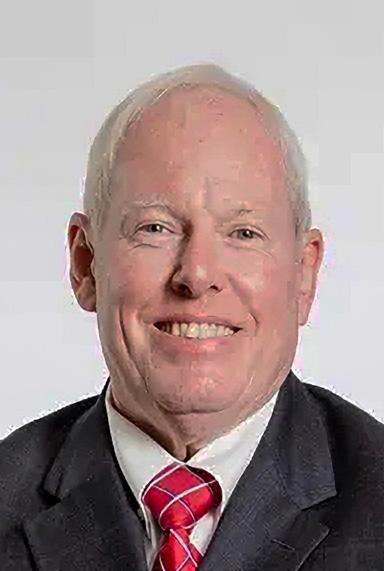


Lenders are no longer willing to take chances on incomplete applications or vague financials. That helps both buyers and sellers avoid surprises during escrow.
Despite recent bank consolidations, financing remains steady.
“The lending industry is strong,” Hyde says. “We’re ready to lend, but buyers need to be prepared.”
Preparation now means more than just having a good credit score. It includes having documentation ready, understanding one’s budget clearly and being realistic about long-term affordability. Those who show up informed are the ones receiving the house keys.
With buyers focused on value and proximity to jobs, developers are taking a strategic approach to growth.
“We’re following infrastructure,” Schoenberg says. “Loops 101, 202, 303, those investments made growth possible in all directions.”
The north side of Phoenix draws extra interest due to its strong schools and job opportunities. However, development there comes with unique challenges.
“We like the north side, but much of the land is held by the state and has to go through the auction process,” Schoenberg says.
He adds that water access is another critical factor influencing where growth can occur. Cities with designated water providers are positioned to expand more easily than those relying on groundwater.
Developers are diversifying their focus
as well, building for a wide range of buyers, from first-time homeowners to retirees.
“We serve everyone from the starter home market to age-qualified communities,” Schoenberg says. “That flexibility helps us ride out any demand shifts.”
For now, Arizona’s legal and regulatory environment feels stable, though industry insiders remain vigilant. Casey Blais, a real estate attorney and partner at Burch & Cracchiolo, describes the landscape as steady with no major shifts looming, at least for traditional residential and commercial real estate.
“That said, affordable housing could be a game-changer,” Blais notes. “Tax incentives for converting commercial properties into residential units are one area where we might see creative solutions emerge.”
Concerns about lease and loan defaults are also on the radar.
“While we’re not seeing anything close to the stress levels during the pandemic, there’s cautious monitoring. The market’s unpredictable, so everyone stays alert,” Blais continues.
Local governments could introduce zoning changes or new policies as they grapple with growing housing demand. Industry players actively engage with lawmakers, aiming to strike a balance between encouraging development and maintaining community stability.
In short, the legal climate is calm but watchful, like a reflection of the market itself.
When analyzing the state of the market in 2025, Zschunke puts it plainly:
“Uncertainty is always there. But buyers aren’t scared off by 6% mortgage rates anymore. They’re informed and ready.”
Schoenberg, the builder, agrees:
“We’ve had some unpredictable years. Now, things are settling into a new normal, and that’s healthy.”
Hyde offers another perspective:
“There are pockets of struggle, including some pre-foreclosures. But those realities create opportunities, too. Staying realistic is key.”
Barker, the investor, sums it like this:
“There’s always business to be done. We’re focused on solid assets and long-term partnerships. For those willing to play the long game, Phoenix remains a smart bet.”
As the rest of the year unfolds, Valley residents can be certain that the housing market isn’t crashing — it’s recalibrating. As prices stabilize, inventory will gradually improve and buyers continue to adjust to a more measured financial landscape. The frantic pace of recent years has softened, but activity continues, especially from wellprepared, intentional buyers.
Phoenix’s appeal continues to grow, fueled by diverse job growth, quality of life and steady in-migration. Yet, challenges like affordability, policy uncertainty and equity gaps still cloud the future.
“We’re bullish on Phoenix, but we’re also pragmatic,” Schoenberg says. “The fundamentals are strong. It’s about patience and perseverance.”

